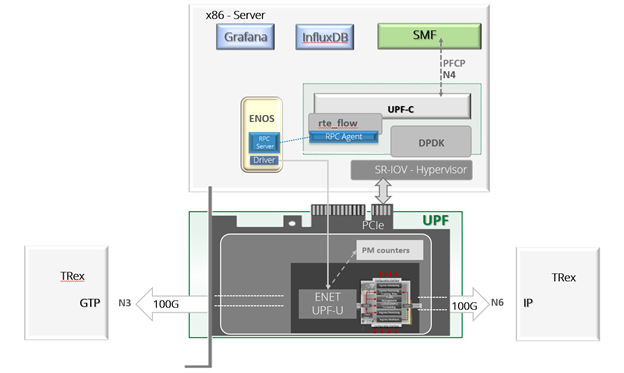Earlier today, Ethernity announced that it has opened a live 5G Core environment and is inviting telecom operators and system integrators to remotely connect to the setup to test out the performance and savings that can be achieved by Ethernity’s 5G UPF Offload solution. Let’s break down this setup into its component parts and then review the benefits of both the testing opportunity and the overall solution.
First, here is a schematic of the 5G Core environment:

The first thing you can see is that there is a TRex traffic generator at each end, one sending 50Gbps of GTP traffic toward the server (across the N3 node) and the other sending 50Gbps of IP traffic (across the N6 node). The traffic enters the server via the Ethernity ACE-NIC100 SmartNIC .
The primary difference between the Ethernity offering and standard UPF processing is the magic that occurs next. The NIC in a normal UPF appliance would forward the traffic to the CPUs within the server for user plane processing. This is cumbersome and inefficient, especially since CPUs are not especially good at handling network processing functions.
The ACE-NIC, however, is already integrated with VPP-based open source UPF software, so the user plane processing can occur directly on the card without the traffic ever having to reach the server. A series of PFCP control commands originating from the vendor’s SMF are relayed (via the N4 interface) to the ACE-NIC via a unique containerized architecture of RTE_Flow DPDK APIs, and the ENET Flow Processor then knows exactly how to process the data (from GTP to IP or vice versa, as well as numerous other user plane functions) and forward it onward.
Meanwhile, the InfluxDB and Grafana applications on the server are capturing the performance throughout this process and reporting it both statistically and graphically in real-time. This will serve as the basis for the operators and system integrators to compare the results of this live testing setup against their typical UPF performance.
By accessing the setup, users can experience how the ACE-NIC100 communicates with other containers of VPP-based third-party UPF software networking elements. The solution fully offloads the user plane traffic without changing the UPF Network Function Virtualization Infrastructure (NFVI) application, releasing server CPU cores and reducing power consumption, enhancing scalability, and assuring deterministic performance.
The solution reduces software complexity and networking overhead, improves latency, and lowers the overall solution cost. It also fits perfectly into the disaggregated network concept by fitting into any white box server, accelerating virtualized network functions, and paving the way to place UPFs at the network edge closer to end user locations.
Now, thanks to this remote setup to our 5G Core environment, 5G mobile operators and system integrators can experience firsthand how to achieve better UPF performance at lower overall cost in the shortest time-to-market.
To reserve a time to access the new 5G Core setup for evaluation, interested parties can contact Ethernity at info@ethernitynet.com.

